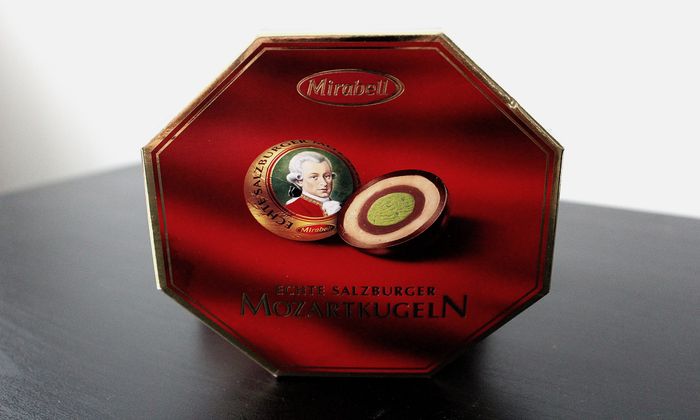Mozart candy: history of the Mozartkugeln (chocolate balls)


Some of my favourite things to do are travelling, history and odd little stories. And the famous Mozart candy combines all three of these things! The Mozartkugeln is a candy made of chocolate balls. You can find them in almost every shop in Vienna (Austria), but it’s a bit harder to find them outside Austria.
So what makes these candy chocolate balls called ‘Mozart’ so famous? Well, let’s have a look at its history:
What are Mozartkugeln? Well, it’s Mozart candy!
For those who have not yet visited Austria (in Europe of course, not Australia.I think these chocolate candy balls would melt immediately there) or are not familiar with Mozart merchandising, the picture below shows you what Mozartkugeln are:
As you can see, it’s a Mozart candy chocolate ball wrapped in a paper with the picture of the artist imprinted on it. (If you need to refresh your memory to remember who Mozart is, I wrote a short article about why I’m a Mozart fan,which you can read here).
But how does it taste? Personally, I like the kugeln (this is the German word that refers to the ball shape). But it’s something that you don’t eat in bulk. The ball itself is in my opinion a bit too big to eat it easily and the candy can make you feel pretty heavy. One, max two, and I’m already stuffed!
Talking about the stuffing, the picture below shows you the ingrediënts. Of course, there is chocolate in it, marzipan, and also some pistachio. And it’s the pistachio and marzipan that give the distinctive taste of the Mozartkugeln.
The history of the Mozartkugeln
But enough about eating this Mozart candy. Let me tell you something about the history of the Mozartkugeln.
The chocolate candy balls are a very typical candy for Austria, the land of Mozart. It’s said that the inventor was Paul Fürst, a baker in Salzburg (another important city in Austria). The story goes that he created the chocolate balls in 1890. And for you travelers: you can still find the bakery in Salzburg, on the Brodgasse nr. 13. Paul Fürst named his chocolate candy balls after Mozart. As a tribute, but also as a smart commercial move.
Mozart candy history: big commercial mistake
Although the baker was smart enough to name his candy after Mozart, he still made a (very) big commercial mistake. Because he didn’t patent the Mozartkugeln. This gave competitors the chance to conquer the market, which they did. And the original Mozart candy was pushed into the background.
Mozart chocolate balls: original versus ‘new’
You can still find the ‘original’ Mozart chocolate balls if you want. You recognize them by the silver coloured paper they are wrapped in. The biggest competitor of baker Fürst, and now market leader when it comes to Mozartkugeln, is the company Mirabell. They wrap the chocolate balls in a red/gold coloured paper, and it’s the Mirabell version that I saw everywhere during my trip to Vienna (if you want to know more about my trip to Vienna, you can read my Vienna report here).
The original Mozart candy is artisanal made, the ones made by Mirabell are industrial. Another difference is the shape: only the industrial (Mirabell) ones are fully round (like in my pictures). The other ones are forced to be a bit flatter. And even the name has to be different: Mozartkugel vs. Mozart-Kugel. Yes, it seems that the Mozart chocolate candy balls are the subject of some hard commercial competition!
Conclusion: the history of the Mozartkugel
While walking around in Vienna, I guessed that there would be some kind of history behind the famous Mozartkugeln. I mean, you literally find the chocolate balls on almost every corner of the street. But I would never thought that the commercial competition between bakers and factories would be this hard. Which is a bit of a shame, because it’s about…tasty chocolate candy balls…
If you are interested in the history of food, I also wrote an article about the origins of the Brussel sprouts and about the first banana.
Extra: How the Mozart candy (Mozartkugeln) is made
As a little extra, I wanted to tell you a bit about how the Mozart chocolate balls are made. Because, besides it’s history, it’s also something curious.
The core of marzipan and pistachio is rolled into a ball. The balls are pinned on a little stick that points upwards. When this is set, the ball on a stick gets covered with chocolate. Afterwards, the little hole of the stick is filled up with the rest of the chocolate.
So if you ever visit Vienna: be sure to try it out! I bet you will find it more tasty than another historical food I already talked about on my blog: the Brussel sprouts and the history of our bananas.
Recent Posts
The origin & history of cricket
It is a sport that is increasingly played worldwide and is the second most played…
The story of the lost island of Testerep
I am writing this article on a typical autumn day with low degrees but a…
The Herald of Free Enterprise 1987
Every year has its misfortunes, even my birth year 1987. And when I look at…
The history of Delft Blue: visit to the Royal museum
In 2023, I took a trip to Delft in the Netherlands (Europe), where you can…
Bialetti: history of a coffee pot
A while ago, I already wrote about the history of the cappuccino. It is only…
Nello and Patrasche: a dog of Flanders
The most Belgian (and Flemish) persons are perhaps Nello and Patrasche. They are fictional characters…